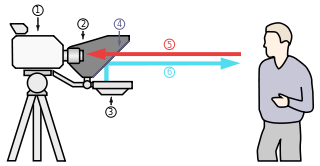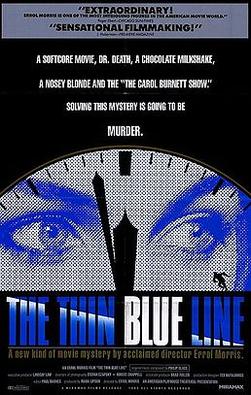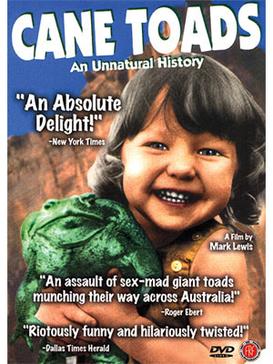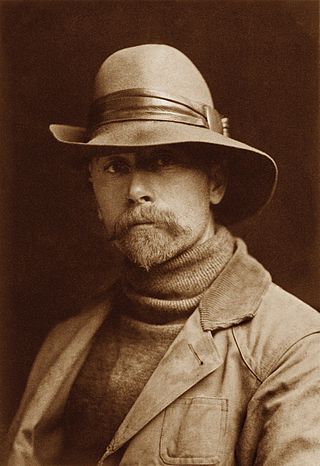Related Research Articles

A documentary film or documentary is a non-fictional motion picture intended to "document reality, primarily for instruction, education or maintaining a historical record". Bill Nichols has characterized the documentary in terms of "a filmmaking practice, a cinematic tradition, and mode of audience reception [that remains] a practice without clear boundaries".

Errol Mark Morris is an American film director known for documentaries that interrogate the epistemology of their subjects. In 2003, his documentary film The Fog of War: Eleven Lessons from the Life of Robert S. McNamara won the Academy Award for Best Documentary Feature. His film The Thin Blue Line placed fifth on a Sight & Sound poll of the greatest documentaries ever made. Morris is known for making films about unusual subjects; Fast, Cheap & Out of Control interweaves the stories of a wild animal trainer, a topiary gardener, a robot scientist and a naked mole rat specialist.

Cinematography is the art of motion picture photography.

Fast, Cheap & Out of Control is a 1997 documentary film by filmmaker Errol Morris.

A teleprompter, also known as an autocue, is a display device that prompts the person speaking with an electronic visual text of a speech or script.

A close-up or closeup in filmmaking, television production, still photography, and the comic strip medium is a type of shot that tightly frames a person or object. Close-ups are one of the standard shots used regularly with medium and long shots. Close-ups display the most detail, but they do not include the broader scene. Moving toward or away from a close-up is a common type of zooming. A close up is taken from head to neck, giving the viewer a detailed view of the subject's face.

The Thin Blue Line is a 1988 American documentary film by Errol Morris, about the trial and conviction of Randall Dale Adams for the 1976 shooting of Dallas police officer Robert W. Wood. Morris became interested in the case while doing research for a film about Dr. James Grigson, a psychiatrist known in Texas as "Dr. Death" for testifying with "100 percent certainty" of a defendant's recidivism in many trials, including that of Randall Adams. The film centers around the "inconsistencies, incongruities and loose ends" of the case, and Morris, through his investigation, not only comes to a different conclusion, but actually obtains an admission of Adams' innocence by the original suspect of the case, David Harris. The "thin blue line" in the title "refers to what Mr. Morris feels is an ironic, mythical image of a protective policeman on the other side of anarchy".

The Fog of War: Eleven Lessons from the Life of Robert S. McNamara is a 2003 American documentary film about the life and times of former U.S. Secretary of Defense Robert McNamara, illustrating his observations of the nature of modern warfare. It was directed by Errol Morris and features an original score by Philip Glass. The title derives from the military concept of the "fog of war", which refers to the difficulty of making decisions in the midst of conflict.
This article contains a list of cinematic techniques that are divided into categories and briefly described.

Cane Toads: An Unnatural History is a 1988 documentary film about the introduction of cane toads to Australia. Cane toads were introduced to Australia with the aim of controlling a sugar cane pest, the cane beetle, but they over-multiplied and became a serious problem in the Australian ecosystem. It is often humorous, and is used in high schools and colleges as a complement to curricula in biology, ecology, environmental science, anthropology, geography, and communication. It was filmed in Cairns and Gordonvale in Queensland.

Portrait photography, or portraiture, is a type of photography aimed toward capturing the personality of a person or group of people by using effective lighting, backdrops, and poses. A portrait photograph may be artistic or clinical. Frequently, portraits are commissioned for special occasions, such as weddings, school events, or commercial purposes. Portraits can serve many purposes, ranging from usage on a personal web site to display in the lobby of a business.
Morris Engel was an American photographer, cinematographer and filmmaker best known for making the first good-quality, internationally-recognized American film "independent" of Hollywood studios, Little Fugitive (1953), in collaboration with his wife, photographer Ruth Orkin, and their friend, writer Raymond Abrashkin.
Documentary mode is a conceptual scheme developed by American documentary theorist Bill Nichols that seeks to distinguish particular traits and conventions of various documentary film styles. Nichols identifies six different documentary 'modes' in his schema: poetic, expository, observational, participatory, reflexive, and performative. While Nichols' discussion of modes does progress chronologically with the order of their appearance in practice, documentary film often returns to themes and devices from previous modes. Therefore, it is inaccurate to think of modes as historical punctuation marks in an evolution towards an ultimate accepted documentary style. Also, modes are not mutually exclusive. There is often significant overlapping between modalities within individual documentary features. As Nichols points out, "the characteristics of a given mode function as a dominant in a given film…but they do not dictate or determine every aspect of its organization."

Afocal photography, also called afocal imaging or afocal projection is a method of photography where the camera with its lens attached is mounted over the eyepiece of another image forming system such as an optical telescope or optical microscope, with the camera lens taking the place of the human eye.

Standard Operating Procedure is a 2008 American documentary film written and directed by Errol Morris that explores the meaning of the photographs taken by U.S. military police at the Abu Ghraib prison in late 2003, the content of which revealed the torture and abuse of its prisoners by U.S. soldiers and subsequently resulted in a public scandal.
First Person is an American TV series produced and directed by Errol Morris. The show engaged a varied group of individuals from civil advocates to criminals, and ran for two seasons, in 2000–2001.
Robbie Cooper is a British artist working in various media, including photography, video and video game modifications.

American Dharma is a 2018 British-American documentary film directed by Errol Morris. The film follows the career of political strategist Steve Bannon. The film was released on November 1, 2019, by Utopia.

The Sony Xperia 1 is an Android smartphone made by Sony. Part of Sony's flagship Xperia series, the device was announced to the public at a press conference held at the annual 2019 Mobile World Congress event on February 25, 2019. It’s the world's first smartphone with an ultrawide 21:9 aspect ratio 4K HDR OLED display, dubbed Cinema Wide, and Sony's first triple-lens camera system featuring Eye AF eye-tracking technology seen in the company's Alpha line of professional-grade cameras. The Xperia 1 was later joined by a more compact, the Xperia 5, which was revealed on 5 September 2019. Compared to the Xperia 1, the Xperia 5 has a smaller 1080p screen, a smaller battery, and a non-centrally aligned camera module.
The Meta Quest Pro is a mixed reality (MR) headset developed by Reality Labs, a division of Meta Platforms.
References
- ↑ Chris Higgins (November 2, 2007). "The Interrotron". Mental Floss. Retrieved 2024-02-07.
- ↑ https://www.newyorker.com/culture/the-new-yorker-interview/the-world-is-of-course-insane-errol-morris-interview
- ↑ Chris Higgins (November 2, 2007). "The Interrotron". Mental Floss. Retrieved 2024-02-07.
- ↑ John Pavlus (September 30, 2016). "Errol Morris's Secret Weapon for Unsettling Interviews: The Interrotron". Fast Company. Retrieved 2024-02-07.
- ↑ "Errol Morris Interrotron". Teleprompter Mirror. Retrieved 2024-02-07.
- ↑ "Interrotron: an Interviewing Tool Essential to the Documentaries of Oscar Winner Errol Morris". No Film School. Retrieved 2024-02-07.